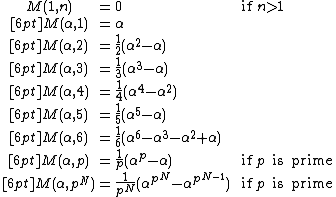- Relations between M and N
- Examples
- Identities
- Cyclotomic identity
- Applications
- References
In combinatorial mathematics, the necklace polynomial, or Moreau's necklace-counting function, introduced by {{harvs|txt|authorlink=Charles Paul Narcisse Moreau|first=C.|last=Moreau|year=1872}}, is the family of polynomials  in the variable
in the variable  such that
such that
By Möbius inversion they are given by
where  is the classic Möbius function.
is the classic Möbius function.
A closely related family, called the general necklace polynomial or general necklace-counting function, is:
where  is Euler's totient function.
is Euler's totient function.
Relations between M and N
The above formulas are easily related in terms of Dirichlet convolution of arithmetic functions  , regarding
, regarding  as a constant.
as a constant.
- The formula for M gives
 ,
, - The formula for N gives
 .
. - Their relation gives
 or equivalently
or equivalently  , since n is completely multiplicative.
, since n is completely multiplicative.
Any two of these imply the third, for example:
by cancellation in the Dirichlet algebra.
Examples
Identities
{{main | Necklace ring }}The polynomials obey various combinatorial identities, given by Metropolis & Rota:
where "gcd" is greatest common divisor and "lcm" is least common multiple. More generally,
which also implies:
Cyclotomic identity
{{main | Cyclotomic identity }}Applications
The necklace polynomials  appear as:
appear as:
- The number of aperiodic necklaces (or equivalently Lyndon words) which can be made by arranging n colored beads having α available colors. Two such necklaces are considered equal if they are related by a rotation (but not a reflection). Aperiodic refers to necklaces without rotational symmetry, having n distinct rotations. The polynomials
 give the number of necklaces including the periodic ones: this is easily computed using Polya theory.
give the number of necklaces including the periodic ones: this is easily computed using Polya theory. - The dimension of the degree n piece of the free Lie algebra on α generators ("Witt's formula"[1]). Here
 should be the dimension of the degree n piece of the corresponding free Jordan algebra.
should be the dimension of the degree n piece of the corresponding free Jordan algebra. - The number of monic irreducible polynomials of degree n over a finite field with α elements (when
 is a prime power). Here
is a prime power). Here  is the number of polynomials which are primary (a power of an irreducible).
is the number of polynomials which are primary (a power of an irreducible). - The exponent in the cyclotomic identity.
References
- {{citation | last1=Moreau | first1=C. |authorlink=Charles Paul Narcisse Moreau | title=Sur les permutations circulaires distinctes (On distinct circular permutations) | url=http://www.numdam.org/item?id=NAM_1872_2_11__309_0 | language=French | jfm=04.0086.01 | year=1872 | journal=Nouvelles Annales de Mathématiques, Journal des Candidats Aux écoles Polytechnique et Normale, Sér. 2 | volume=11 | pages=309–31}}
- {{Citation | last1=Metropolis | first1=N. | author1-link=Nicholas Metropolis | last2=Rota | first2=Gian-Carlo | author2-link=Gian-Carlo Rota | title=Witt vectors and the algebra of necklaces | doi=10.1016/0001-8708(83)90035-X | mr=723197 | zbl=0545.05009 | year=1983 | journal=Advances in Mathematics | issn=0001-8708 | volume=50 | issue=2 | pages=95–125 | url = https://www.sciencedirect.com/science/article/pii/000187088390035X/pdf?md5=3cfd1a39f5235b827cb18f8a3e99ccc2&pid=1-s2.0-000187088390035X-main.pdf
}}
- {{cite journal |last1=Reutenauer |first1=Christophe |title=Mots circulaires et polynomies irreductibles |journal=Ann. Sc. Math. Quebec |date=1988 |volume=12 |issue=2 |pages=275–285}}
- Rick Edmonds
- Rick Ellback
- Rickelle Smith
- Rickels, David
- Rickenbacker 300 series
- Rickenbacker 381
- Rickenbacker 400 series
- Rickenbacker (airport)
- Rickenbacker International
- Rickenbacker (international airport)
- Ricken Railway
- Ricker Pond State Park
- Ricketsiosis
- Rickett, Charles
- Ricketts, Anthony
- Ricketts, Charles
- Ricketts, Christopher
- Ricketts, David
- Rickettsia parkeri rickettsiosis
- Rickettsia philipii
- Ricketts Island
- Ricketts, Mark
- Ricketts, Matthew
- Ricketts, Michael
- Ricketts, Thomas








